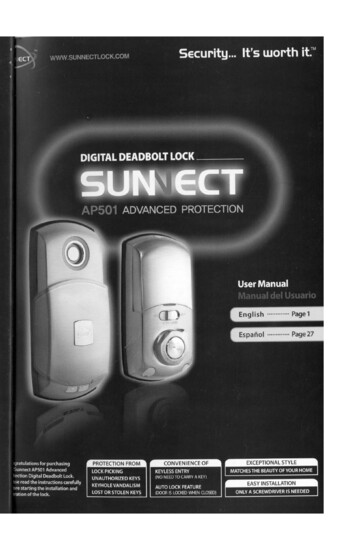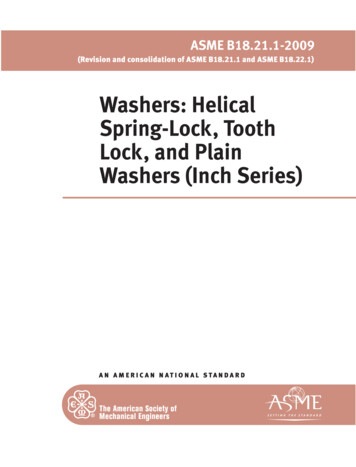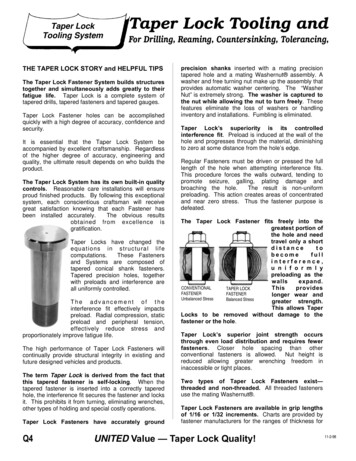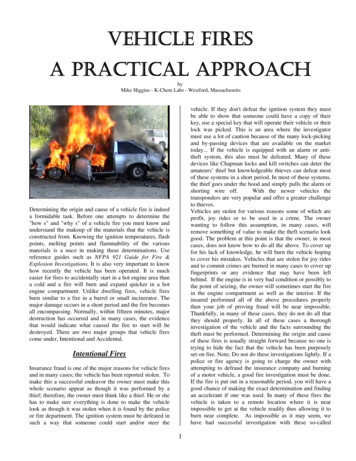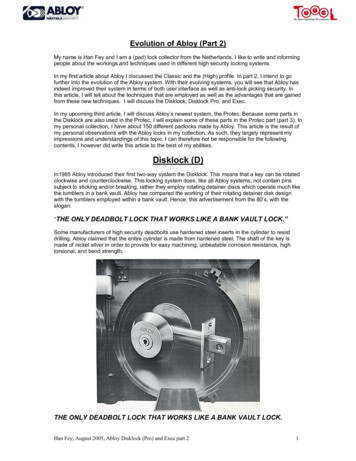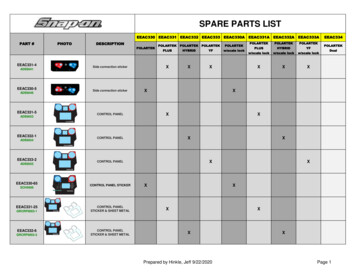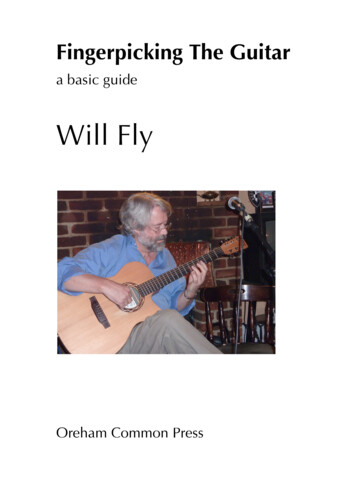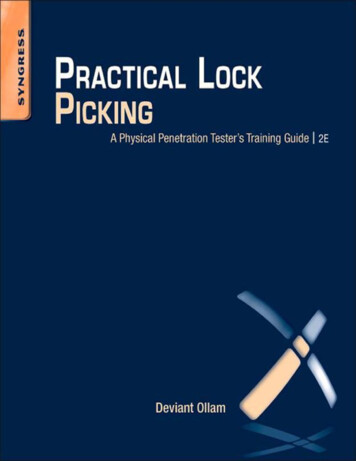
Transcription
Practical Lock PickingA Physical Penetration Tester’s TrainingGuideDeviant OllamShane Lawson, Technical Editor
Table of ContentsCover imageTitle pageCopyrightDedicationForewordAuthor’s NoteAbout the AuthorAbout the Technical EditorEthical ConsiderationsScenario OneScenario TwoScenario ThreeSo what do you think?Do not pick locks you do not ownDo not pick locks on which you relyChapter 1. Fundamentals of Pin Tumbler and Wafer LocksPin Tumbler LocksWafer Locks
SummaryChapter 2. The Basics of Picking—Exploiting WeaknessesExploiting Weaknesses in LocksPicking with a Lifting TechniquePicking with a Raking TechniqueSummaryChapter 3. Beginner Training—How to Get Very Good, VeryFastA Word on EquipmentThe Basics of Field StrippingStarter ExercisesLearning ExercisesChallenging Yourself FurtherUsing Rakes and JigglersWafer Lock ExercisesExtra HintsSummaryChapter 4. Advanced Training—Learning Some AdditionalSkillsPick-Resistant PinsSpecialized Picking TechniquesSpecialized Picking Tools
Practice ExercisesReal-World Locks Which O er Greater ChallengesSummaryChapter 5. Quick-Entry Tricks—Shimming, Bumping, andBypassingPadlock ShimsSnapping and BumpingComb PicksAmerican Lock Bypass ToolDoor BypassingSummaryChapter 6. They All Come Tumbling Down—Pin Tumblers inOther Con gurationsTubular LocksCruciform LocksDimple LocksThe Secret Weakness in 90% of PadlocksSummaryAppendix: Guide to Tools and ToolkitsGuide To Di erentiating Pick ToolsA Note About Tension ToolsPick Kit Suggestions
ConclusionIndex
CopyrightAcquiring Editor: Chris KatsaropoulosDevelopment Editor: Heather SchererProject Manager: Paul GottehrerDesigner: Kristen DavisSyngress is an imprint of Elsevier225 Wyman Street, Waltham, MA 02451, USA 2012 Elsevier, Inc. All rights reservedNo part of this publication may be reproduced or transmitted in any form or by any means,electronic or mechanical, including photocopying, recording, or any information storageand retrieval system, without permission in writing from the publisher. Details on how toseek permission, further information about the Publisher’s permissions policies and ourarrangements with organizations such as the Copyright Clearance Center and the CopyrightLicensing Agency, can be found at our website: www.elsevier.com/permissions.This book and the individual contributions contained in it are protected under copyright bythe Publisher (other than as may be noted herein).NoticesKnowledge and best practice in this eld are constantly changing. As new research andexperience broaden our understanding, changes in research methods or professionalpractices, may become necessary. Practitioners and researchers must always rely on theirown experience and knowledge in evaluating and using any information or methods
described herein. In using such information or methods they should be mindful of theirown safety and the safety of others, including parties for whom they have a professionalresponsibility.To the fullest extent of the law, neither the Publisher nor the authors, contributors, oreditors, assume any liability for any injury and/or damage to persons or property as amatter of products liability, negligence or otherwise, or from any use or operation of anymethods, products, instructions, or ideas contained in the material herein.Library of Congress Cataloging-in-Publication DataApplication submittedBritish Library Cataloguing-in-Publication DataA catalogue record for this book is available from the British LibraryISBN: 978-1-59749-989-7Printed in the United States of AmericaFor information on all Syngress publications visit our website athttp://store.elsevier.com12 13 14 15 16 10 9 8 7 6 5 4 3 2 1
DedicationTo my Mother and FatherMy father taught me to take pride in the things that I own, totreat them with care, and use them properly so that they serve mewell. It is because of him that I own a ten-year-old truck and athirty-year-old jeep, both of which run just ne with half a millionmiles between them. I also cannot thank him enough for teachingme to shoot at a young age.My mother taught me the value of getting the most out of theequipment you own by learning how it functions, inside and out, soyou can x it if the need should arise. I can remember a time when Iwas all of about nine years old and the iron in our house stoppedworking. My mom explained to me that you don’t throw somethingaway just because it is old. Fiddling with the cord, she was able todetermine where a break existed in the wire it was down near theplug.I stood there, wide-eyed, as she cut the line, stripped the wireends, and inserted them into an after-market replacement plug. Shelet me hold the screwdriver and tighten the contact points whereelectricity would again ow to the appliance. I never forgot what itfelt like to take something you owned and get more out of it usingyour own skills and tools. You never can quite tell when you rstbecome a hacker, but for lack of a better point on the calendar I willalways believe it started for me on that Sunday afternoon.
My parents still own that iron to this day.
ForewordI feel somewhat like an old man remarking in this fashion, but thisbook is a great example of the wonderful time in which youcurrently nd yourself. To be alive and learning right now whenthere are accessible resources such as this about lockpicking, withbeautiful illustrations and lessons written with passion visible onevery page, that is truly something.I re ect back and compare the state of things now with howthey were when I was young. I dreamed of being able to open locks.I knew it could be done, but I did not know how. In the 1980s,when my hunger for this knowledge was getting quite powerful, thestate of educational materials was very di erent. Through ads inmagazines I found a small publisher in the United States o ering abook called The Complete Guide to Lockpicking by Eddie the Wire. Thisbook was an inspiration, both for paying close attention during myEnglish lessons in school (all the better to understand Eddie’s everyword) and for obtaining pick tools (which could only be found at anexpensive spy shop for the equivalent of 200 at the time).It was with great excitement that I sat down at home with myrst proper tool set, my book, and some locks from the store.However, it took an entire long and frustrating day before the rstpadlock clicked open. You know (or your will soon nd out!) how itfeels your rst time you will always remember that moment! The
rush was amazing and addictive. From then on I was hooked andtried to pick any lock I could (legally!) get my hands on.In the following decade I published about my passion forlockpicking and have since presented many hands-ondemonstrations at security conferences. It wasn’t long beforeinterested parties began forming sport picking clubs. A group oflockpickers in Germany formed SSDeV; two years later I was amongthose who formed a group in the Netherlands. In 2001 ourorganization became TOOOL The Open Organisation OfLockpickers. Whenever anyone asks why our name is spelled withthree O’s, we remind them that to be good at picking there is noother path than to practice Over and Over and Over again. TOOOLhas continued to grow and today we are pleased to be able tointroduce new people to the topic of locks and security all aroundthe world.I rst met Deviant Ollam when presenting about lockpicking ona trip to the United States. I was attempting to spread the idea thatknowledge of physical security matters should be spread much likethe details and reports of computer security matters any industrythat encourages open, honest discussion will always have betterproducts, more informed consumers, and better security foreveryone overall. When someone showed me slides from one ofDeviant’s lectures I immediately understood that he could be quitean ally. He not only totally grasped the concepts when it came tolocks, but he also understood the bigger picture regarding the stateof the security industry overall.Deviant believes in the right of the people to understand howtheir hardware works in order to properly evaluate it and use it. He
now sits on the Board of Directors of the US division of TOOOL anddedicates much of his time to teaching, traveling, and makingcertain that those who wish to learn can truly understand andfollow along with this knowledge. He has also put a lot of energyinto developing his illustrations, diagrams, and training materials.The images that appear in this work are unlike any other that mostof us have encountered in reference woks at any other time it’samazing to compare resources like this book to the ones which havebeen available up until now.This book is quite an achievement. It is the rst new text toappear in ages showing some more advanced and up-to-date topics.This book is also perhaps the rst text ever which is both suitablefor beginners and yet also has so much to o er to those seekingadvanced, professional training. Deviant clearly things clearly witheasy, owing words paired with technical drawings of greatprecision. An absolute beginner starting out knowing essentiallynothing about the subject of locks and lockpicking and be wellversed in this topic in almost no time.Perhaps you just want to open locks as a hobby, or you may betraining as a professional security consultant. It could be that youwant to know more about the locks you buy for your own needs, oryou may be in charge of advising businesses on their securitydecisions. No matter what your background is, if you want new andfascinating insight into this world I don’t think any book will begiving you a better introduction to this eld than this one.Thank you, Deviant, for writing this book and spreading theknowledge.
Barry WelsFound and President,The Open Organisation Of Lockpickers
Author’s NoteThis book was written over the course of one month, during whichtime I sat at my desk wearing my battered Navy watch cap anddrinking hard cider, scotch, and jasmine tea, as the same hugeplaylist repeated over and over and over again full of songs fromFlogging Molly, Girlyman, Emancipator, The Ramones, BillieHoliday, Trash 80, and a guitar-playing goat.Thank you to Rachel, Matt, and everyone else at Syngress forsomehow having the vision to see that such a process wouldsomehow result in a decent book. Thank you to Shane Lawson,Babak Javadi, and Barry Wels for being so instrumental to thisenterprise along with me.I have to thank Barry Wels, Han Fey, and Mike Glasser for trulyopening my eyes about the potential for grasping and understandinglockpicking. TOOOL and the other locksport groups have been soinstrumental in this process. Thank you to Schuyler Towne, EricMichaud, Eric Schmiedl, and especially Babak Javadi for keepingTOOOL alive and growing here in the US. To Chris, Jim, Jon, Dr.Tran, Ed, the Daves, and especially Mouse thank you for makingthe local TOOOL chapter what it is. Having been with you in thebeginning makes me feel amazing. Steve, JVR, Dr. Tran, and DavePloshay you’re the greatest ever when it comes to running publiclockpicking events on the road with Babak, Daisy, and I. Shea, Scott,Michael, Katie, and everyone else who is showing so much interest
and energy in getting local TOOOL chapters started in new places,we all salute you.Thank you to Renderman, Jos, Rop, Til, Nigel, Kate, mh, Ray,Suhail, Gro, Hakon, Kyrah, Astera, Rene, Mika, Morgan, Saumil,Andrea, Daniele, Federico, and Francisco, and all of our otherinternational friends who make us feel at home no matter how farwe travel.TOOOL would like to thank all of the other sporting, hobbyist,and amateur lockpicking groups who help to spread knowledge andbuild interest in this fascinating eld. SSDeV, LI, FALE, and theFOOLS are full of wonderful people who love to teach and have fun.An extra special thanks goes to Valanx, Dosman, and the rest of theFOOLS for reminding us to not be so serious, even when we havesomething serious to say. Some other local groups who have been soinstrumental to spreading interest, enthusiasm, and awareness aboutlockpicking are:DC719 – Thank you for starting and such awesome lockpickingcontests at DEFCONDC303 – Thank you for making lockpicking look badass onnationwide TVDC949 – Thank you for making handcu s picking look badass onClosed-Circuit TVThank you to Scorche, Datagram, and Ed for your beautifulphotos, good advice, amazing collections, and invaluable friendship.Without Q, Neighbor, Russ, MajorMal, and Zac showing o allof their wickedly fun gadgets over the years I would have never hadthe slightest insight into matters of electronic security.
I have to thank my old neighbor Tom for listening to my rstrehearsal of my original presentation slides, and my new neighborsGeo and Heather for being there as I developed new ones.Thank you to Johnny Long for showing the world that even ahighly technical presentation should always be amusing andenjoyable and for reminding us that we all have a responsibilityto do right by our brothers and sisters on this planet. May all that isgood watch over you and your family, Johnny, as you continue tohelp others in foreign lands.Thank you to Dark Tangent for rst suggesting that I turn thiscontent into a proper training course, and to Ping and everyone elsewho works tirelessly so that Black Hat can keep ticking along.Extra special thanks to Bruce and Heidi for ShmooCon, where Igave my very rst public lecture about lockpicking. You and allthose who put in the monumental e ort every year are the reasonShmooCon remains my favorite conference to this day.Thank you as well to everyone behind the scenes at (deepbreath) AusCERT, Black Hat, CanSecWest, CarolinaCon, DeepSec,DEFCON, DojoCon, ekoparty, HackCon (go, team Norway!),HackInTheBox, HOPE, LayerOne, NotACon, PlumberCon, PumpCon,QuahogCon, SeaCure, SecTor, ShakaCon, SOURCE, SummerCon,ToorCon, and all of the other events who have been kind enough toinvite me to spread knowledge of this topic to new people.We wouldn’t be the researchers we are without the help of theworld’s Hackerspaces (particularly PumpingStation:One and theMetaLab) hosting us and helping us reach out to others.This work would not have been possible had I not met BabakJavadi, who has given endless advice, encouragement, and
invaluable constructive criticism of my material.I o er great thanks to Nancy, who was there as I discovered theextent to which one could do amazing things with Photoshop. Sospecial was my time with Janet, Don, and those who were therewhen I was nding my voice as a teacher. So invaluable was mytime with Jackalope, who was there with me as I was discoveringthe conference circuit you made me realize that people actuallyliked listening to what I have to say.I cannot express my pleasure and good fortune of meetingChristina Pei while writing this. You reminded me that eventeachers of scienti c material can be funny and casual in theirdelivery. Having you in my life makes me feel like I can doabsolutely anything.Most of all, I o er my deepest and most heartfelt thanks toDaisy Belle. You have shown me more kindness, love,understanding, and support than I have ever dreamed one personcould give. From running the logistics of TOOOL to managing dailyoperations for The CORE Group to coordinating all of my travel (allthree of those tasks each being practically a full-time job) you areinstrumental to all of the projects I attempt and to my life as awhole. Your love is what sustains me that, and your awesomesandwiches. and a special thank-you to those in the hacker communitywho get involved. Those who attend conferences, preparepresentations, research exploits and publicly disclose them properly,those who continue seeking new skills, who want to explore, whowant to understand, who want to learn, touch, and do. To anyonewho has ever sat in one of my lectures and asked an insightful
question or gone home to try out what they have learned toanyone who has not just watched but gotten up and tried their handat Gringo Warrior, Pandora’s Lock Box, the De ant Box, ClusterPick,or any of the other contests that I have run over the years to allthose who make the community what it is I thank you from thebottom of my heart.
About the AuthorDeviant Ollam’s rst and strongest love has always been teaching.A graduate of the New Jersey Institute of Technology’s Science,Technology, and Society program, he is always fascinated by theinterplay that connects human values and social trends todevelopments in the technical world. While earning his BS degree atNJIT, Deviant also completed the History degree program federatedbetween that institution and Rutgers University.While paying the bills as a security auditor and penetrationtesting consultant with The CORE Group, Deviant is also a memberof the Board of Directors of the U.S. division of TOOOL, The OpenOrganisation Of Lockpickers. Every year at DEFCON and ShmooConDeviant runs the Lockpicking Village, and he has conducted physicalsecurity training sessions for Black Hat, DeepSec, ToorCon,HackCon, ShakaCon, HackInTheBox, ekoparty, AusCERT, GovCERT,CONFidence, the FBI, the NSA, DARPA, and the United StatesMilitary Academy at West Point. His favorite Amendments to theU.S. Constitution are, in no particular order, the 1st, 2nd, 9th, and10th.
About the Technical EditorShane Lawson is the Director of Commercial and Federal SecuritySolutions in the Cyber Security Division of Tenacity Solutions, Inc.where he focuses on penetration testing, security assessments, andsupply chain risk analysis for his clients. He previously served as asenior technical adviser and security analyst for numerous federalagencies and private sector rms. In his free time, Shane researchesphysical security systems and teaches others about physical securitybypass mechanisms. Shane is a U.S. Navy veteran, where he servedas an information systems security manager and communicationswatch o cer for over 10 years.
Ethical ConsiderationsDear reader, you’ve picked up quite the interesting book indeed.During its course, you will learn many fascinating things about locksand their operation but before you begin, I pose to you three ethicaldilemmas of varying degrees:Scenario OneSarah is driving around town running various errands. As sheapproaches an intersection where she as the right of way, anothervehicle cuts her o , forcing her to swerve in order to avoid acollision. She misses the other vehicle, but runs into the median inthe process, damaging one of her front wheels. The other vehicledrives away, and since she has only liability insurance, Sarah willhave to pay for the repairs out of pocket. Later in the day, as shewaits in the checkout line at her local grocery store, she recognizesthe cashier as the driver of the vehicle that cut her o . As her itemsare totaled up, she considers confronting the cashier about theincident. Sarah decides to let the issue drop, and the cashier informsthat her total is 76.19. She hands the cashier a 100 bill andreceives her change. Now counting her change, Sarah realizes thatshe received 33.81 in change instead of 23.81, an excess of 10.What should Sarah do?Scenario Two
It’s a beautiful day Jeremy and his girlfriend Emily decide to visitthe local botanical center for a nice walk. As they enter, he realizeshe forgot his student ID at home and wonders if the center wouldstill allow him to purchase tickets at the student pricing. A quickexchange with the pleasant lady working at the ticket counterreveals that he would have to pay full price for the tickets. Defeated,he pays for the two tickets and proceeds with Emily inside. As theyexplore the various areas, Emily mentions that she heard about anew collection of exotic owers that she wanted to see. Jeremynotes the location of the Special Exhibits area on the map and theybegin to navigate their way there. As the couple approaches thearea, they nd themselves blocked by a roped o area with a signthat reads “Due to extenuating circumstances, this exhibit is temporarilyclosed. We apologize for the inconvenience.” Emily is visiblydisappointed and Jeremy considers unhooking the rope and enteringthe exhibit anyway. After all, they paid full price for admission!Shouldn’t they have the right to see all of the exhibits?Scenario ThreeWhile working on a project in his apartment Chad is interrupted bya knock at his door. When opens the door, he nds his friend Zachstanding there, ustered. Zach explains that he’s left his house keysat the o ce and needs to get into his apartment. He already triedcalling the landlord, but there was no answer at the number. Zachknows that Chad recently read a book about lockpicking and wasfairly skilled at opening many locks that he has purchased forpractice. Zach wants Chad to open his apartment door so he can get
his spare key from within. Should Chad try to open the door forZach?So what do you think?Let’s look at the rst scenario. How much of fault and respectiveliability fall on the cashier? Even though Sarah had the right of way,did she have any other options? Did she have a di erent directionshe could have taken the car? Could she have stopped? Regardlessof the level of fault of the cashier in regards to the car accidentearlier in the day, many people would return the extra 10 withouthesitation. After all, it’s not even the cashier’s money. It belongs tothe grocery store. Even if the scenario was modi ed and the driverof the o ending vehicle was also the owner of the store, manywould argue that the issue of the car repair and the accuracy of thegrocery transaction are separate, and should be dealt withaccordingly.Now let’s move to the dilemma within the botanical center.What’s the appropriate course of action to take there? In regards tosimply bypassing the rope barrier, one must remember that in thiscase, the botanical center is legally considered private property. Assuch, the owner of the property has the right to restrict movementof visitors as they see t, up to and including removal of visitorsfrom the property. If you had guests in your home and told themthat a particular room was o limits, wouldn’t you be upset if theyentered anyway? It’s also important to consider the practicalimplications of the sign. Even though there wasn’t muchinformation available on the sign as to why the area was closed o ,there are many good reasons for such an action. It’s possible that the
plants were currently undergoing special care or treatment, orperhaps hazardous chemicals were in use. Maybe the center was justsimply short-sta ed because an employee called in sick and theydidn’t have anyone to oversee the area. Regardless of the reason, it’sclear a boundary was drawn and it’s important to respect that. Thebest course of action to take would be for Jeremy or Emily to bringup the issue with an employee or a manager, and explain theirdisappointment. The manager would likely give them some daypasses to come back at another time, or might even arrangesupervised tour. Barriers aren’t often used without cause and it’simportant to consider both the ethical and practical implicationsinvolved with breaking them.The ethical signi cance of locks in our society is a veryintriguing matter. Locks have historically had a very important andpersonal place in our lives. They are used as a means of security.They prevent others from seeing that which we do not wish to beseen, and they keep our property and families secure from intruders.The ethical issues surrounding lockpicking are a bit more cloudedfor many people. It is not an issue that is dealt with very often, andit is di cult for some to understand.For many people the interactions with a lock fall into threebasic categories:1. A lock is opened with a key by an authorized user.2. A lock is picked open or bypassed by a locksmith on behalf of anauthorized user.3. A lock is compromised via picking or physical force by an unauthorized entity (i.e. burglar).Often times when discussing the hobby of lockpicking with others,
you may be asked if you are a locksmith. If you are not, many willlook at you with an oddly and some may think that you nefariouspurposes in mind. After all, if you aren’t using a key, and you’renot a locksmith, what business do you have opening locks withoutthe key? Most people never think about the fourth scenario:4. A lock not being used for the purposes of security is treated as apuzzle by an intrigued party.Many have tried explaining this fourth possibility, only to bemet with incredulous looks friends, family, and others. As a resultsometimes the situation is explained as an endeavor of research inthe name of better security. However, whether you choose to adoptthis hobby simply as a diversionary past time or as part of asecurity-related career, it is essential that you are mindful of matterssurrounding ethics and law.In most states possession of “burglary tools” is consideredillegal if it can be shown that one had intent to commit a crimeusing said tools. In such cases, nearly anything can be considered aburglary tool, including but not limited to lock picks, crowbars,screwdrivers, pliers, and even spark plugs. However, a couple statesnow have laws that make mere possession of lock picks without alicense a crime. While such laws stem mostly from scammers doingbusiness as “locksmiths” and defrauding the public, such legislationa ects the lockpicking community, as well.It should go without saying that it is your responsibility to knowyour local laws regarding the possession of lock picks, but in generalif one remains safe and ethical regarding such things no troublearises. It is here that I would like to introduce what are commonlyreferred to in the community as the two golden rules of lockpicking:
1) Do not pick locks you do not own.2) Do not pick locks on which you rely.Why the two rules? Well it’s actually fairly di cult to getoneself into an undesirable position if one follows these two rules.Let’s talk about the rst rule.Do not pick locks you do not ownIn this usage, I refer to ownership in the strictest sense. It’simportant to note that there is a clear delineation betweenownership of a lock and permission to use the lock. When rstlearning about lock picking, many immediately go to the nearestlock they can nd and start practicing. Often times this is anapartment door, dormitory door, or o ce door. In these examplesnote that one does not own any of the locks. A key is provided bythe owner or landlord for authorized access as the lock wasdesigned to be used. Thus, access to the key does not implyownership. Now let’s look at the second rule.Do not pick locks on which you relyIt may not be immediately apparent why this rule is important, butyou must understand that it is possible for a lock to be damaged oreven occasionally disabled by picking. Not only does repeatedpicking of a lock put premature and abnormal wear on the cylinderand pins, in some con gurations locks can become disabled ordamaged in a way that prevents their normal operation. If thishappens to a lock that regularly use, you’ve now disabled or brokenpart of your own security. You may lock yourself out of your house,
or prevent yourself from being able to secure the property. Shouldyou accidentally damage someone else’s lock, you’re nowresponsible for the damage caused to their property in addition toany labor and repair needed to resolve the problem.Are there exceptions to these rules? In a way, yes. If someoneo ers you one of their locks to try (for example, a practice lock fromtheir own collection) that is okay as long as everyone understandsthat there is always a risk of damage or premature wear. If you getlocked out of your own house but do happen to have some picks,you may elect to try to pick your house lock to get back in, with theunderstanding that if you fail, you may damage the lock and thelock may require replacement. In light of these speci c exceptions, Io er the amended rules:1. Do not pick locks you do not own, except with express permissionby the owner of the lock.2. Do not pick locks on which you rely, except when risks of damageare fully considered.Still, it’s much easier to use the original verbiage, as most willunderstand the implied exceptions noted above.Now, let us return to our friends Chad and Zach. In this case,neither Chad nor Zach own the lock that is on Zach’s apartmentdoor. Additionally, Zach relies on his apartment door lock in orderto secure his residence. This means that if it is damaged, they havenow damaged the landlord’s property and broken part of Zach’ssecurity. Chad would be violating both golden rules of lockpicking ifhe picks the lock. The best course of action would be to wait for thelandlord, return to the o ce for the key, or if absolutely necessary,
call a locksmith if the landlord allows for it. Proper, tradinglocksmiths are insured and bonded, which protects both thelocksmith and the property should an issue arise regarding damage.So, dear reader, we come to the close of our ethical discussion,but not to the end of our journey. I ask that you keep in mind all ofthe topics that were outlined, and keep in mind the implications ofbeing too cavalier with the knowledge you learn. Remain respectfulof others’ property and boundaries, and have fun. Don’t forget thegolden rules:Do not pick locks you do not own.Do not pick locks on which you rely.I hope you enjoy the magic of lockpicking as much as I do.Babak JavadiDirector, The Open Organization of Lockpickers
Chapter 1Fundamentals of Pin Tumblerand Wafer LocksChapter OutlinePin Tumbler LocksWafer LocksSummaryWhile there are a multitude of lock designs on the market today,produced by many di erent manufacturers, the bulk of theseo erings are not in widespread use. Nearly all of the locks that youare likely to encounter on a day-to-day basis stem from just a fewbasic varieties, and the mechanisms inside of all of these devicesoperate in almost
American Lock Bypass Tool Door Bypassing Summary Chapter 6. They All Come Tumbling Down—Pin Tumblers in Other Congurations Tubular Locks Cruciform Locks Dimple Locks The Secret Weakness in 90% of Padlocks Summary Appendix: Guide to Tools and Toolkits Guide To Dierentiating Pick Tools A Note
